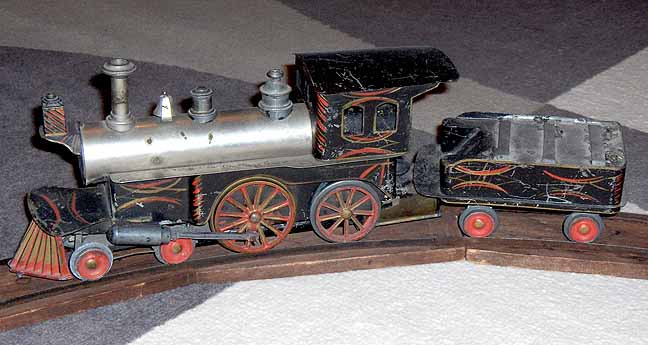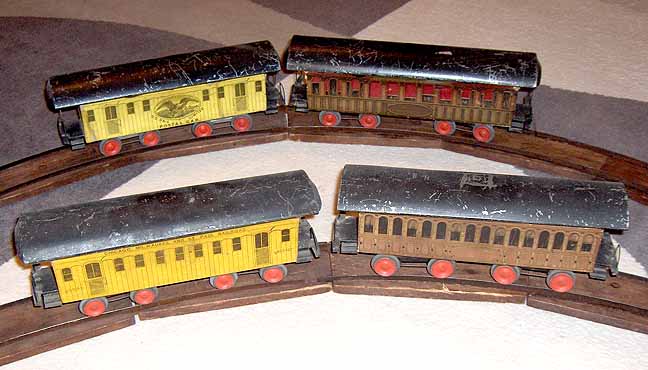Back to Sidestreet Bannerworks
Click here to find out how your engine can be featured!
.


Beggs steam locomotives
by Alexander D. Procyk
Houston, Texas
Photos by the author
August, 2010
Live steam in the parlor was nothing new when, in 1871, Eugene Beggs started producing 1-gauge trains in Connecticut. Scale demonstration models had been produced alongside the real ones since the beginning of the railway age, and England, in particular, was prolific in producing small-scale “dribbler” toys since the 1860s. Some of these dribblers were carried by American department or specialty stores but Beggs was the first American company to tap into this market with mass production. For a surprisingly long time, he was about the only one.
We know a great deal about Beggs' life and company through the efforts of Walter Lucas, a prolific railroad historian who wrote two articles on Beggs in the August and September 1949 editions of Railroad Magazine. Beggs began production with the locomotive shown in photo 1; an “American Standard” but with a coal bunker instead of a tender, presumably to reduce train weight or minimize chances for derailments. This bunker design was used for most of Beggs' engines but he did make a line of more expensive locomotives with proper tenders in 4-, 6-, and 8-wheel configurations.
Beggs' engines were reduced to the simplest form possible: a pot boiler with alcohol burners and oscillating cylinders. No reverse cluster, whistle, or safety valve were included. A sight glass was installed in the backhead. The engines ran on low pressure (<40 psi) and the springs that were used to hold the cylinders against the yokes doubled as safety valves. Speed is controlled by wick setting and train length. The earliest 4-4-0 engines had coupled drivers and a flexible front truck that could negotiate an oval. Within a few years the engines were redesigned. Apparently the coupling between drivers was deemed too complicated, and the pivoting bogie was considered excessive. In fact, straight track was considered more trouble than it was worth and most of Beggs' engines were reduced to 2-2-2 arrangements, with a small pony truck permanently set at a fixed radius. Engines were driven by only one larger driver, with a slightly smaller idler wheel behind it that sort of looked like a second driver but really wasn't. Track was comprised of strap rails set in solid-wood bases. Seven sections made up a circle. Why seven is anyone's guess.
Beggs' catalog numbers denote the amount of elaboration that came with a particular engine. The #1 model had the simplifications described above but was stripped down without headlight, bell or the decorative valence around the wheels (see photo 2 for a late version of the #1).

Photo 2. A late version of Beggs #1. Note the large, unpowered rear axle.
Numbers 2 and 3 were identical in appearance, with wheel valences and other trim, but the pilots were set at different radii (see photo 3 for a #3).

Photo 3. A Beggs #3 on Beggs track.
Number 4 was a 4-2-2 with flexible front trucks, and occasionally came with a tender. Number 5 was a proper 4-4-0, with larger tender, and occasionally came with handrails and flagpoles. There have been several found with “water wings” -- small cylindrical projections below the boiler to increase the surface area for the burner to heat. The #6 had an eight-wheel tender, water -tube boiler, and was considerably larger than the other versions.
Because Beggs' engines ran on low pressure, the cars were made to be as light as possible. This was done with strawboard and lithographed paper. A large manufacturer of hatboxes and such was contracted to supply the bodies. Four cars comprised most of Beggs' rolling stock, including a postal car, baggage/postal car, and passenger car all from the same 7.5” long body. A longer, 15” drawing-room car was the most popular.

Photo 4. A variety of original rolling stock on Beggs track.
Photo 4 shows a basic collection of the cars on original track. The cars were made in a variety of colors (yellow, blue, and green for the postal and baggage car; red, yellow, blue for the shorter passenger car; and brown, green, red, and blue for the parlor car, just to name a few) and occasionally came with road names and other forms of lithography. Roofs were usually radial in style, though some came with clerestories. Most of these cars had pot-metal wheels with two different diameters. The inner wheels were of a smaller diameter to tip the cars towards the center of the circle to compensate for the centrifugal force. The only known freight cars are gondolas. A later series of cars was brought out around 1905 with metal bodies and Ives tinplate wheels.
Beggs initially hired a foreman names Jehu Garlick, who went out on his own in 1889, making trains that turned out to be almost identical to Beggs'. He patented a reverse cluster and included it in a few of his locomotives. This was Beggs' only real direct competition until Weeden came along with their Weeden Dart in 1898. Beggs' indirect competition was all the cheaper imported steam trains (of which there were many) and clockwork trains (which were far less difficult to deal with).
By 1900, electric trains began to catch on. As a result, Beggs, though he did well, never achieved the status of Ives, Märklin, Bing, or many other early toy manufacturers, which counted their employees in the thousands. Beggs counted his in the half-dozen. However, longevity can overcome size and Beggs' trains were manufactured with hardly any change for 37 years. It is not an exaggeration to say that Beggs probably manufactured 30,000 locomotives and, as a result, #s 1, 2, and 3 are not at all hard to find if you know where to look. However finding one in very good, original, and complete condition is quite difficult. Engines numbers from 4 and up are very difficult, with eight-wheel tender locomotives being almost nonexistent.
Operation
Although I don't run any of my Beggs engines because of concern for the original paint (the repainted loco in photo 1 was done by Walter Lucas in the 40s and I don't have the heart to risk it), a friend of mine occasionally fires his up. Lacking original track, he laid track in the correct diameter for his fixed-radius engine, using period-correct strap steel.
Firing the engines requires nothing more than filling the boiler to a little over half full with water and filling the burner with ethanol. I have a set of original instructions, which state “Expansion and contraction will sometimes cause the gauge glass to leak a little, this does not prevent the engine from working properly. A few grains of fine Indian meal, which should be placed inside of the boiler on the bottom part of the gauge glass after the water has been poured out, will stop any leak.” You may want to try this the next time your Aster is leaking.
After getting up steam, a simple push in the desired direction gets it going. The action is surprisingly smooth and effortless, although with so few moving parts, maybe it isn't that surprising. With proper wick length, there isn't any excess flame to scorch the paint, at least for one or two demonstration runs. Despite Beggs' concern about his engines being poor pullers, they had to be coupled to two tinplate, 1-gauge cars to keep the speed in check. Two pasteboard cars wouldn't have done it.
Here's a movie of a Beggs locomotive in action.
Thanks to Don Hedenburg for supplying the video of the Beggs engine.
If, for some reason, you can't view it, click here.




Back to Sidestreet Bannerworks
Click here to find out how your engine can be featured!
This page and its contents
Copyright Sidestreet Bannerworks, 2010